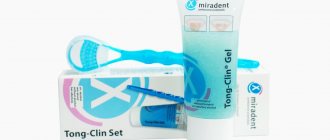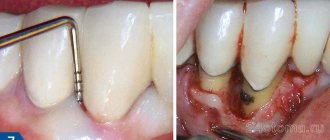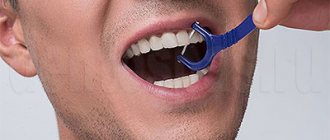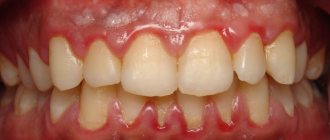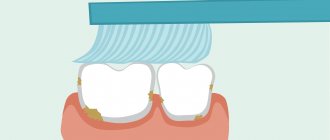22.11.2019
White plaque in the mouth is one of the signs of candidal stomatitis. This pathology is caused by the Candida fungus and most often affects young children. In addition to deposits, redness appears on the oral mucosa, which causes severe discomfort.
Types of plaque on the lips in the morning
Experts say that a coated tongue and a slight coating in the mouth after a night's sleep is a normal phenomenon and is observed in both children and adult men and women.
The norm is a thin layer of whitish plaque, through which the pink surface of the mucous membrane is visible. The smell may be weak or absent altogether. The film itself can be easily cleaned off with toothpaste during morning oral hygiene. The pathology is a thick layer of plaque and its dark color (brown, gray), which is either not completely removed during cleaning or soon appears again. The same applies to bad breath.
Establishing a diagnosis
If a plaque is detected on the palate of an adult’s mouth, the doctor undertakes:
- Listen to the patient's complaints.
- Collect anamnesis.
- Inspect the mucous membrane and skin.
- Make a microscopy of a scraping from the oral cavity.
Additionally, the patient may be referred for consultation:
- to a dermatologist - in order to identify fungal infections of other systems and organs;
- endocrinologist - to detect endocrine pathologies;
- an allergist - in order to determine the body’s sensitization to the materials from which dentures are made.
After clarification of the diagnosis, treatment is prescribed.
Causes of white plaque and brown film
Many people suffer from candidiasis in childhood, but this disease also occurs quite often in adults (for more details, see the article: symptoms of thrush in adults in the mouth (with photo)). The causative agent of thrush is the candida fungus. A film and white lumps appear on the tongue, palate, inner surface of the cheeks and lips (mainly on the lower surface), as if you had eaten cottage cheese. In the severe stage, they acquire a brown or green tint. What causes candidiasis:
- excessive use of medications that suppress the immune system and suppress intestinal microflora (antibiotics or hormonal agents);
- intestinal dysbiosis and other gastrointestinal diseases;
- weakened immunity;
- pregnancy period;
- low-quality dentures;
- bad habits.
An exacerbation of thrush is accompanied by an increase in body temperature, pain, itching and burning, a change in taste and difficulty swallowing. Often candidiasis in the mouth is accompanied by candidiasis in the intestines.
This is a lesion of the oral mucosa. The main cause of stomatitis is poor hygiene. Pathogenic microbes cause irritation and inflammation, the mucous membrane swells, becomes painful and becomes covered with a white film and mucus. Saliva is produced more intensely, an unpleasant odor appears and gums may bleed.
Stomatitis can be aphthous, allergic, herpetic, vesicular, catarrhal, ulcerative and traumatic. In any case, its appearance is associated with a disruption of the immune system.
Problems with the gastrointestinal tract
In the first place here is intestinal dysbiosis - and although, according to the official list, it is not considered a disease, it occurs very often and causes people a lot of inconvenience and problems. White plaque also appears with gastritis and peptic ulcers. If you do not deal with the problem, it gradually becomes dense and dark and provokes the appearance of bad breath. When plaque is accompanied by bitterness, sour taste and dryness, burning and nausea, this means stomach disease.
Other reasons
It happens that white plaque in the mouth indicates other diseases. Consider this relationship:
Main manifestations
White plaque on the palate of an adult is accompanied by the following symptoms:
- feeling of itching and burning in the mouth;
- the appearance of small ulcers on the mucous membrane;
- hypersensitivity to temperature stimuli;
- feeling of a lump in the throat;
- hypersensitivity to mechanical irritation.
Mouth ulcers are bright pink or red in color. If the wounds become infected, profuse purulent discharge appears.
Primary symptoms
One of the first symptoms of candidal stomatitis is the appearance of dry mouth and white plaque. Deposits appear in the form of ragged or neat small spots.
This symptom is accompanied by severe discomfort, which is expressed in burning and itching of the affected areas.
As the disease progresses, a white coating appears on the inside of the cheeks. Next, the gums and tonsils are affected.
At the initial stage of the pathology, plaque can be easily removed with a cotton swab. Beneath it, painful red lesions are found.
Secondary manifestations
Additional signs include:
- increased sensitivity of the mucous membrane. Eating salty, spicy and sour foods causes pain;
- decreased sense of taste;
- the appearance of a specific metallic taste;
- bleeding ulcers;
- the appearance of mycotic lesions (the skin in the corners of the mouth becomes red, then becomes covered with microscopic cracks. Then a white coating appears in the corners of the lips);
- the occurrence of pain when swallowing saliva;
- an increase in general temperature (this is due to the body’s response to the pathogenic activity of fungi);
- unmotivated weakness, drowsiness;
- the appearance of bad breath;
- slowing down the rate of speech;
- enlargement of taste buds on the tongue.
The “spotty” coating on the sky gradually merges into a continuous white film. Its structure becomes denser and it becomes more difficult to remove.
Causes of white plaque
White plaque on the lips and mouth occurs in children and adults. Some of them indicate serious health problems, others are more harmless and easy to eliminate. In this regard, the causes of plaque formation are divided into pathological and non-pathological. The first include:
- infectious lesions of the body;
- HIV;
- stomatitis;
- gingivitis;
- tonsillitis;
- diseases of the gastrointestinal tract;
- liver problems;
- oral candidiasis (thrush);
- endocrine diseases;
- diabetes;
- exacerbation of chronic pancreatitis;
- hormonal disbalance.
Non-pathological causes of the appearance of a film around the mouth are:
- the influence of certain medications, in particular antibiotics;
- use of dentures;
- insufficient oral hygiene;
- bad habits (smoking, drinking alcohol);
- frequent stress that causes dysbiosis of the oral cavity or intestines;
- unbalanced diet, consumption of unhealthy salty foods.
Read also: Why does the tip of the tongue hurt as if it were burned?
Symptoms
Clinically, depending on the location of the lesion, candidiasis can occur in the form of inflammation:
- tongue - glossitis;
- corners of the mouth - angulitis;
- mucous and red border of the lips - cheilitis.
The first symptoms of the disease are the appearance of pain when eating, discomfort, burning and dry mouth. Then, first redness and then a white cheesy coating forms on the oral mucosa.
- Acute thrush.
Lasts no more than 2 months, chronic - more than 2 months. The most common form is acute pseudomembranous candidiasis. Clinically, it is characterized by the appearance of pinpoint plaque on the mucous membrane of the cheeks and tongue (glossitis); after scraping off the plaque, redness and swelling of the mucous membrane remain underneath.
- Acute atrophic candidiasis.
Accompanied by complaints of pain when chewing, swallowing and talking, dry mouth, changes in taste. In this case, dry, atrophic mucosa is determined, plaque accumulates in the folds and is difficult to remove.
- Chronic hyperplastic candidiasis.
Most often it occurs in smokers; it may become malignant. In this case, a white coating in the form of plaques is observed, which is located on the hyperemic mucosa. Patients complain of dryness and burning in the mouth, changes in taste, pain when eating and talking.
- Chronic atrophic candidiasis.
It develops in the presence of prosthetic structures that put pressure on and injure the mucous membrane. There is practically no plaque; the prosthesis bed exhibits dryness, atrophy and soreness.
Why does a white film appear after sleep?
It is difficult to give a definite answer to the question why plaque accumulates near the mouth in the morning. There can be many reasons. Some are more harmless, others are alarming.
A white film on the lips after sleep occurs due to involuntary drooling at night. Saliva has a bactericidal effect and is involved in the primary processing of food, which simplifies its swallowing and digestion.
At night, the secretion of the salivary glands slows down, and the discharge decreases several times. Sometimes the glands continue to function at full capacity at night. Saliva dries on the lips, leaving a residue in the form of light spots. The mucous membrane is easily visible through this plaque, it does not have a strong odor, and there are no other symptoms that would cause discomfort.
Nighttime drooling occurs when:
- stuffy nose;
- increased stomach acidity;
- inflammation in the gastrointestinal tract;
- helminthic infestations;
- disturbances in the functioning of the nervous system;
- infectious diseases in the oral cavity (caries, periodontal disease).
The formation of dry transparent crusts on the lips caused by constant dry mouth is a consequence of xerostomia, which develops against the background of hyposalivation in various disorders and diseases:
- lack of vitamin A, B and E in the body;
- Chronic mumps;
- neurological disorders;
- dysfunction of the salivary glands;
- period of menopause in a woman;
- botulism;
- Sjögren's syndrome.
If plaque forms daily and covers the lips and tongue with a thick white layer, and after removal during morning hygiene, appears again, this indicates the presence of internal problems or damage to the oral cavity by a fungal infection.
Pay attention to accompanying symptoms:
- plaque color (white, brown, yellow);
- consistency and appearance (thick, curdled, dry, wet, sticky);
- the presence of an unpleasant odor;
- pain in the abdomen, side, throat;
- poor appetite;
- disturbing dream.
If a dark, yellow, brown or almost black thick, sticky coating is found on the lips in the closure zone in the morning, then it becomes necessary to undergo examination by a gastroenterologist. This film can cover the gums, teeth, and tongue. It is difficult to wash off with water; normal hygiene is not enough to remove it. The surface of the mucous membrane has to be scraped and rubbed to remove dried mucus. This phenomenon is often accompanied by dry mouth. Such symptoms indicate problems in the functioning of the abdominal organs, in most cases – inflammation of the pancreas. To eliminate it, it is necessary to treat the underlying disease.
Yellow-brown dry crusts, as can be seen in the photo on the Internet, appear after permanent tattooing of the lips due to injury to the skin by punctures. This process accompanies the recovery period and is normal during the healing of the epidermis. Dry plaque on the outside forms 2-3 days after the procedure and goes away on 5-7 days. It is not recommended to remove crusts and peeling by force, but to wait until they are rejected on their own. During healing, it is worth using wound healing and antiseptic ointments and creams.
- Often pregnant women develop a white coating on their tongue and lips. This is due to a reduced protective function of the body, which provokes susceptibility to fungal infection, exacerbation of caries, and gingivitis. Mucosal deposition can be affected by changes in hormonal levels. A small coating in the morning, which is easy to clean off and does not cause discomfort, is considered normal. If there is an abundance of white, curd-like flakes, they speak of the action of a fungus of the genus Candida.
- Girls, using lipstick or gloss, witness it rolling off and turning into sticky white lumps on their lips, especially during the cold season. This happens when the skin dries out and peels. Particles of the rejected epidermis mix with cosmetics and create a light coating. To get rid of this problem, you should use hygienic medicated lipstick or moisturizer.
Features of therapy
Treatment involves the use of topical drugs and internal medication.
To treat the oral cavity in adults, with very high sensitivity of the mucous membrane, it is allowed to use a diluted Lugol's solution (2 tsp per 200 ml of warm water from a kettle).
You can also lubricate the oral cavity with baking soda diluted in water (1/2 tsp per 150 ml of warm boiled water). The procedure should be carried out 2-3 times a day.
Drug therapy involves the use of antifungal and painkillers. Antihistamines are additionally used as prescribed by an allergist.
Use of antifungal agents
The main antifungal drugs are presented in the table:
| A drug | Description | Mode of application | How to use |
| Ketocanazole, 200 mg | The main effects are antiandrogenic, antifungal, fungicidal, fungistatic. The drug helps inhibit the synthesis of ergosterol, triglycerides and phospholipids. Against this background, fungi lose their ability to form colonies and threads. | Oral | The daily norm is 1-2 tablets for 14 days. Then, after the disappearance of acute symptoms - 1 tablet 24 hours - until the white deposits and ulcers completely disappear. |
| Fluconazole, 50 mg | The main effect is antifungal. Has a highly specific effect. | Oral | 50-100 mg/24 hours, for 1-2 weeks, until the sensation of plaque in the mouth completely disappears. |
| Nystatin, 1% | Effects – antifungal, fungistatic. The presence of double bonds in the composition helps ensure high tropism of the antibacterial drug to the sterols of the fungal cell membrane. | Local impact | The oral cavity should be treated 2 times/24 hours until the white plaque and other symptoms disappear. The approximate duration of the course is 10 days. |
| Clotrimazole, 1% | The product belongs to the group of imidazole derivatives. Effects: antibacterial, antiprotozoal, trichomonacid, broad-spectrum antifungal. | Local impact | The oral cavity is treated 2 times/24 hours until the white plaque disappears. The average course duration is 7 days. |
| Chlorhexidine bigluconate, 0.05% | The main effect is antiseptic. | Local impact | Intended for the treatment of mouth ulcers. 3 times/24 hours, 7 days. |
How to avoid brown and white plaque in the corners of your mouth
You can prevent plaque in the corners of your lips by leading a healthy lifestyle, giving up smoking and alcohol. Immunomodulatory therapy will help increase the body's protective function. As a result, a person will become less susceptible to fungal infections and inflammatory processes. A timely visit to the dental office will prevent the infection from growing in the mouth. You cannot take medications independently and uncontrollably, especially antibiotics that affect the state of the intestinal microflora.
Why there is a white coating on the tongue: causes and treatment
Many people are concerned about such a problem as the appearance of a white coating on the tongue.
In most cases, it forms in the morning and is a sign of the activity of bacteria that accumulate in the oral cavity due to the fact that during sleep a person’s salivary glands do not function as actively as during wakefulness. Read also: There is a white sore on the inside of the lip
This is completely normal. But there are a number of other reasons why adults may develop a white coating on the tongue. Some of them may be evidence of health problems.
It is considered a serious cause for concern if a thick layer of plaque with an unpleasant odor constantly accumulates on the tongue, which is difficult to remove and quickly restored. Below we will try to figure out why a white coating appears on the tongue of adults, we will talk about the reasons that cause its appearance, and we will not forget to mention effective methods of treatment at home.
If the oral cavity is covered with a white coating
Teeth, probably more than any other structure in our body, can cause a lot of trouble if not taken care of properly. This happens because they carry the beginnings of many diseases of the digestive system, and can also significantly reduce immunity, especially if they are constantly exposed to all kinds of inflammation. The importance of timely prevention of dental diseases is no longer disputed by anyone. The oral cavity is especially susceptible to many diseases. Among them, there are diseases with fairly similar symptoms, the main of which is the appearance of white plaque on the mucous membrane of the gums, cheeks and tongue.
We list the diseases associated with the appearance of white plaque in the oral cavity :
- pachydermia of the mouth; - leukoplakia; - white spongy nevus of Cannon; - Lichen planus; — candidiasis (thrush); - chemical burns.
Candiosis and leukoplakia, just like oral pachyderma and chemical burns, are localized in any part of the oral cavity. Lichen planus can also occur anywhere in the mouth, but most often appears on the surface of the mucous membrane of the cheeks. White spongy nevus of Cannon is localized only on the surface of the buccal mucosa.
Let's talk in more detail about the features of these diseases.
Thus, oral pachyderma is usually caused by the presence of a persistent irritant. The raised, white lesion is caused by hyperkeratosis, a thickening of the oral epithelium secondary to healthy mucosa. When the irritant is removed, healing occurs, lasting for two to three weeks.
If a white spot is found in the oral cavity, and sometimes a convex plaque with clearly defined edges, these are characteristic signs of leukoplakia. When this disease manifests itself in a more severe form, the designated area will become compacted and bumpy, and cracks and erosion may appear on it over time.
Smoking is most often to blame for the occurrence of leukoplakia. So smokers need to be more careful about caring for and maintaining order in their oral cavity. In addition, leukoplakia can appear due to thermal, chemical, and mechanical irritants. Leukoplakia is often a precancerous disease, since the most severe type of this lesion can develop cancer. Fortunately, diseases are almost always treatable. At the same time, the plaque that occurs during this disease, unlike the same candidiasis, is not removed by simple scraping.
Candidiasis, or thrush, is a greasy white patch that occurs in sick children, frail elderly people, and in patients receiving high doses of corticosteroids or broad-spectrum antibiotics, or those suffering from acquired immunodeficiency syndrome (AIDS). Candiosis responds well to antifungal therapy after eliminating predisposing factors.
Cannon's white spongy nevus most often affects the cheeks symmetrically and can be treated without much difficulty, as does lichen planus, the grayish-white papules of which can even disappear spontaneously.
Remember that only a firm hand and the experience of a specialist accumulated over time will effectively save you from such diseases. If you have similar symptoms or suspicions, do not try to self-medicate - contact your dentist. The Apollonia dental clinic, located next to the Chertanovskaya metro station, offers a wide range of dental services in the treatment of diseases of the teeth and gums, as well as providing services such as prosthetics, implantation, teeth whitening and much more. You can consult with specialists by calling the numbers listed in the “Contacts” section.
Causes of white plaque on the tongue
All adults have a white coating on the tongue. Its appearance in the morning is normal. But if it occurs immediately after cleaning the oral cavity, and begins to become thicker, this may indicate the emergence and progression of some disease.
The reasons for the appearance of white plaque on the tongue in adults are varied:
- Tongue lesions in various diseases - infectious, internal organs, hypovitaminosis, dysbacteriosis, oncology and others.
- Acute and chronic lesions of the tongue itself: inflammation, infections, exposure to medications.
- Not associated with diseases: poor hygiene, eating white foods, alcohol, smoking, unsuitable toothpaste and mouthwash.
What does it mean? The location of the plaque allows you to accurately determine the organ that needs treatment:
- The tongue is covered with a white coating in the center. This arrangement of plaque, accompanied by small cracks, indicates developing gastritis or some kind of malfunction of the stomach. If no other symptoms are felt, and the plaque itself is thin and not very thick, then the disease is at the very beginning of its inception. Adjust your diet and daily routine, limit physical activity, and soon everything will get better.
- Middle part of the tongue: the liver is projected on the left edge, the pancreas on the right, and the stomach in the middle.
- Base of the tongue: the edges correspond to the kidneys, the area in the middle to the intestines. The accumulation of whiteness at the base can signal the presence of a significant amount of toxins and waste in the intestines. This is a sign of incipient gastritis, stomach or duodenal ulcers, especially if there are cracks or the plaque has acquired a grayish tint. For treatment, it is worth adjusting your diet.
- If the plaque is on the sides of the tongue, but near the tip, then it indicates the presence of pulmonary diseases, a sure signal for smokers “it’s time to quit, otherwise it will be too late.” Well, if the same marginal plaque is shifted to the root of the tongue, he warns about developing nephritis, saying: “it’s time to visit a urologist.”
If the coating on the tongue is thin and light, there is not a lot of it, then there is nothing to worry about. The norm is when the color of the tongue is visible through the white veil. If this organ is covered with a dense layer of white deposits, then this is an alarm signal. Based on the color, location and thickness of the plaque, they determine what exactly is wrong with a person.
- Thickness - a small plaque indicates the beginning of the stage of the disease; such a defect is a frequent companion to ARVI. A thick layer of white mucus indicates chronic illness or a serious infectious process.
- Color - varies from white to yellow or gray, the darker the color, the more dangerous the pathology.
- Form - plaque can be greasy or dry, curdled, moist.
- Location - the tongue can be completely covered or localized in spots on the surface.
Also, physiological whitening within normal limits is allowed after drinking tea, coffee, and some dishes. Beets, blueberries, sweets with dyes, and dairy products cause color changes. You need to know that this is an acceptable phenomenon, and in 2-3 hours everything will return to normal.
White-yellow coating on the tongue
If the coating on the tongue is white-yellow in color, this clearly indicates diseases of the liver and gall bladder. You may have cholecystitis, bile stasis, biliary dyskinesia. Stagnation of bile must be treated to avoid the appearance of gallstones.
There may be gallstones. It could be viral hepatitis. A yellow color at the base of the tongue can also be a sign of jaundice. Moreover, a yellow coating on the tongue is often accompanied by bitterness in the mouth and nausea, there may be a bitter taste in the mouth, and sometimes vomiting.
Read also: Quick help for toothache
For what reasons does it appear?
White plaque in the mouth in adults occurs for the following reasons:
- development of endocrine pathologies;
- metabolic disorder;
- taking medications (antibiotics, hormonal drugs);
- vitamin deficiency;
- chronic infections of the nasopharynx and oral cavity;
- hepatitis (in particular hepatitis C).
Sometimes this symptom signals the development of cancer processes. In 10% of cases, intestinal cancer manifests itself this way.
What does it mean to have a whitish coating in your mouth in the morning?
In 80% of cases, this symptom is provoked by dry mucous membranes. This happens when a person sleeps with his mouth open - the appearance of deposits is due to a violation of natural hydration.
Another possible reason is impaired saliva production.
In women, this symptom occurs against the background of hormonal changes. Expectant mothers, as well as women in menopause, are at risk.
Appearance of yellowish deposits
A yellow coating appears in smokers, as well as in fans of black tea and coffee. If it is present in small quantities, there is no need to worry. If the deposits are poorly removed and are accompanied by additional symptoms, we may be talking about liver damage.
Possible reasons for the appearance of yellow deposits:
- gallstones;
- acute pancreatitis;
- cholecystitis;
- hepatitis.
A noticeable greenish tint may indicate stagnation of bile.
What white deposits on the tongue are considered normal?
There is no need to worry too much if your tongue is covered with a white coating in the following cases:
- The entire surface of the tongue is covered with a thin, translucent film.
- The organ has natural mobility and flexibility.
- There is no strong unpleasant odor reminiscent of rotten fish.
- The film is easily removed when brushing your teeth.
- The pink surface shines through the film.
- There is no unpleasant feeling of discomfort or pain.
- General health is good, there are no various pathological diseases.
Language can be called an indicator of the state of the human body. If the nature of the plaque has changed: it has become thick, has some tint, is difficult to remove, or has an unpleasant odor, you should pay attention to your health. Lack of vitamins, climate change, and changes in diet can affect the condition of the oral cavity.
Candidiasis in the oral cavity
A fungal disease caused by yeast fungi - candida. The second name for the disease is thrush. White coating on the tongue is the most common symptom of thrush.
It quickly disappears, like other symptoms of the disease, after the correct therapeutic regimens, including antifungal drugs. A characteristic sign of thrush is the detachment of a white film on the tongue, under which pinpoint ulcerations are found.
Generalized inflammation of all surfaces in the oral cavity, including gums, cheeks, tongue, lips, throat, with a favorable prognosis. One of the first characteristic signs of this condition is the appearance of ulcers on the tongue, cheeks, lips, palate, and so on.
On the tongue, in addition to a white coating, small ulcers of various sizes, from 1 to 10 mm in diameter, are found, often bleeding. Stomatitis often affects children, even infants.
Use of painkillers
The table shows the most effective analgesics. They are prescribed only according to indications.
| A drug | Description | Mode of application | How to use |
| Lidocaine hydrochloride, 1% | A potent local anesthetic. Effects: antiarrhythmic, local anesthetic. | Local impact | Prescribed against the background of hypersensitivity to amide anesthetics. Used for applications, before meals. |
| Procaine, 5 mg/ml, 0.5% | Local anesthetic. | Local impact | In the form of applications before meals and treating the mouth with antifungal drugs. |
Diagnostics
To help your doctor determine the cause of the formation of white plaque, you need to prepare answers to several questions:
- Has the taste changed?
- Do you smoke?
- Is there any pain in the oral cavity?
- What diseases have you been worried about lately?
- When did you first notice a white coating on your tongue?
- Changes in the appearance of the tongue, including swelling and ulcers.
- A list of medications and dietary supplements you take.
In some cases, additional consultation with an infectious disease specialist, gastroenterologist and endocrinologist is required. In addition, it is recommended to undergo blood and urine tests, as well as bacterial cultures.
How to treat white coating on the tongue?
A white tongue in adults most often indicates diseases of the gastrointestinal tract, so it is not recommended to take its appearance lightly; it is best to immediately consult a doctor for advice; timely treatment will relieve problems in the future.
If plaque appears due to physiological factors, there is no need for treatment. It is enough to reconsider your diet and stop eating on the go, eating fast food and exhausting yourself with various diets. You should stop eating spicy food generously seasoned with spices, stop getting carried away with too hot drinks, sandwiches instead of a full meal, and overcome the craving for strong alcoholic drinks. Quitting smoking won't hurt either.
If the coating is thick, its color is dark yellow, and it is not evenly distributed, but in certain areas of the tongue, you should think about malfunctions in the body. In this case, only a doctor can help determine the true cause, and he will also give recommendations appropriate to the case. The main thing is not to delay going to the clinic. Take care of yourself, and everything will be fine.
Folk remedies
A popular method is to remove white plaque using vegetable oil. It originated during the times of Ancient India. To do this, you need to put a little vegetable oil in your mouth, about one teaspoon, then rinse your mouth well and move your tongue as if you are stirring something with it.
This procedure should last at least ten minutes. It is not recommended to swallow the oil, so try to spit it out somewhere. If necessary, repeat the procedure if the plaque has not completely disappeared.
